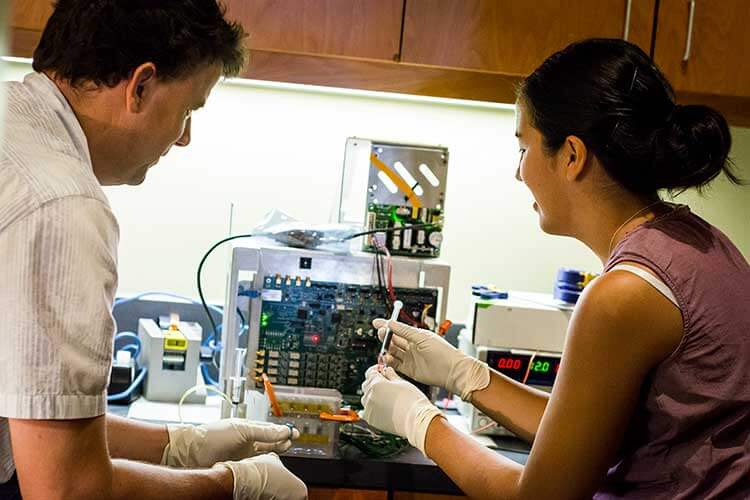
20 Mar When and How to use Functional Ultrasound in an Instrument
It’s been said around Key Tech that ultrasound is my thing. I can’t deny it, I am drawn to ultrasonic applications because they require careful attention to a spectrum of disciplines I enjoy: acoustic, mechanical and materials, electrical and software design. Ignoring just one is likely to doom your application to failure and cause more than a few grey hairs.
Ultrasonic designs begin with figuring out how to get ultrasonic energy where and when you want it and not where and when you do not. This requires an understanding of the physics of acoustic wave propagation. The resulting solutions for most applications are a unique combination of transducer designs, physical geometry and materials.
Like a three legged stool, functional ultrasound relies on a balance of acoustic design, mechanical and material design, and electrical and software designs. It is imperative to carefully consider all three legs of the stool, otherwise it is doomed to fall over eventually. Ultrasound works well when the system is designed as an integrated whole from the start to make it work. If it is just slapped on last minute as a solution to some product development problem, it is usually a disaster.
There are very few other technologies that are as demanding of the careful integration of all of those disciplines. So why bother? Because it is an inherently different measurement technology, it often can sense things others cannot and can have unparalleled dynamic range.
When is Functional Ultrasound the right solution?
Ultrasound has been used for a wide variety of measurements in instruments including fluid property measurement, temperature measurements, detection of bubbles, and detection of cell volume fraction and measurement of clotting properties of blood.
It has also been used for a wide variety of actions in instruments including mixing, lysing cells, heating and separation of particulates including cells. When used appropriately, it can provide an elegant solution.
When applied in the right situations, and when well implemented, functional ultrasound can result in high fidelity solutions to a problem that would be difficult to solve other ways. It is never a simple solution and comes with a degree of complication, but it in many applications it is the best solution.
At Key Tech, we have designed ultrasonic measurements and actuations into dozens of devices and been used frequently as a resource to debug problematic implementations of ultrasonic subsystems. The unifying trait of most of the cases where we have been called upon to make a problematic implementation work is that one or more legs of the stool was designed quickly without adequate consideration to how it integrated with the rest of the system. This is often the result of adding an ultrasonic subsystem late in a product development project.
How to leverage Functional Ultrasound in an instrument
The nature of ultrasonic measurements dictates that in most cases, the ultrasonic subsystem needs to be considered during the early part of a product design. Successful projects will start with paper analysis and modeling to direct the design. This allows the feasibility and potential challenges with an implementation to be identified and addressed before lots of time and capital are wasted on trying to fix a new product development design that is doomed to inadequate performance from the start.
Often that analysis will lead to insights that can actually simplify the design and deliver performance well above initial expectations.
The Hemosonics Quantra system is a great example of the right application of functional ultrasound. Uncontrolled bleeding during and following major surgery is a significant issue. 20% of cardiac surgery patients experience post-surgical bleeding. Prior to Quantra, there was no practical way to make reliable measurements that would inform treatment decisions in real time.
The system measures the elasticity of a blood sample as it clots, providing a direct indication of the rate and quality of the clots. The measurement is made by using acoustic energy to induce oscillation of a clotting blood sample and then monitoring the damped oscillation of the clot to derive the shear modulus. The shear modulus is a direct measure of the quality of the clot, and therefore, hemostatic performance.
To make this measurement, the Key Tech team worked collaboratively with HemoSonics to:
- Design a disposable resonant chamber
- Design an acoustic system that focused the acoustic energy on the resonant chamber
- Design a reliable method to couple the acoustic energy into the disposable that would ensure alignment tolerances were met
- Design electronics that both had the power to induce the oscillation but also the sensitivity to measure the displacement
- Design electronics and signal processing that could rapidly acquire and analyze the data required to make the displacement measurements
- Direct acoustic energy at a blood sample with sufficient power to induce measurable bulk oscillation, and thus enable the measurement.
- Control the entire thermal environment
This was certainly not an easy task, but the path forward was clear once the product requirements were defined and feasibility testing completed.
If you understand that each problem brings with it a unique approach to functional ultrasound and you apply it early in the process, starting with paper calculations and modeling, identifying challenges, and simplifying design, working across all three legs of your stool – functional ultrasound can be a powerful solution.
For more on how we work with functional ultrasound, providing elegant solutions to our clients, reach out and talktous@keytech.com or 410-385-0200.
- When and How to use Functional Ultrasound in an Instrument - March 20, 2019
- Bloody Hell - January 12, 2017
- Do you Want an iHeart Pump? - May 23, 2012


